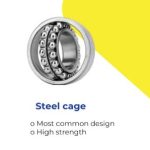Bearing repair is not a new idea, nor has it evolved significantly over the years — which is good news. Repairing damaged bearings is a precise science that has been fine-tuned over time through gradual and careful improvements to provide superior results.
As new designs and technologies improve bearings, growing expertise and technology in bearing repair continue to improve the reliability and performance of reconditioned bearings, making them a more cost-effective alternative to purchasing new bearings.
Bearing remanufacturing can considerably reduce carbon emissions, using only about 10% of the energy required to manufacture a new one. By extending bearing service, remanufacturing prevents component scrapping and waste of natural resources. A remanufactured bearing will also have a shorter lead time than a new one.
Benefits Of Bearing Remanufacturing:
- Lower life cycle costs
- Improved service life
- Machine downtime has been reduced.
- Reduced environmental impact
- Replacement bearings were kept on hand.
- Increased overall asset dependability
Four Levels Of Bearing Repairs
Bearing repair is an exacting science that begins with an expert’s eye. A simple visual inspection kicks off a careful evaluation process that compares common types of bearing damage like scuffing and staining, to their repair potential. The extent of repair work can be determined once the type and extent of damage are determined. Serious damage may necessitate extensive rework, including the replacement of major components. Inspection and rework operations are classified into four levels. The following operations are listed in increasing order of repair time, difficulty, and cost:Repair Type:
- Inspection, Cleaning, written report, and repack.
- Level I along with polishing all the components.
- Level I along with grinding rings plus manufacturing new rollers and cages.
- Level I + Level III + new inner and outer ring.
Bearing Repair
A detailed description of a typical Level III operation follows- The complete cleaning of the bearing.
- Disassemble and inspect each component, etch the serial repair number, and record pertinent bearing information.
- Generate a written inspection report and formal quote.
- Launch a manufacturing order for regrinding races and producing new sets of rolls; generate routings and prints.
- Grind the raceways on the inner and outer rings until no surface damage remains.
- All other surfaces should be polished as well as possible without removing material from critical surfaces.
- Magnet Est and examine the inner and outer rings.
- The amount of material removed from the raceways, as well as the internal geometry, is used to size new rollers.
- Perform necessary cage maintenance.
- Grind rollers to the desired size.
- Rollers are magnets, inspected, and sized.
- Check clearances before assembling the bearing.
- Save, pack, and ship.
When to repair?
Despite its many advantages, reconditioning is not always the best option for a damaged bearing. The difficulty in properly utilizing bearing repair services is determining whether or not a bearing requires repair and deciding which options are the most cost-effective and long-term. Visual inspection is the first step in determining whether a bearing requires repair. A thorough examination of additional criteria, such as the following, aids in determining the need for repair:- Is the bearing beginning to reach or past its recommended life expectancy?
- Have operating temperatures surpassed 200 degrees Fahrenheit?
- Is the bearing subjected to excessive vibration?
- Has the bearing been subjected to sudden lubrication or temperature changes?
- Early detection of a problem via routine checks can save businesses unnecessary downtime and expense while also allowing them to capitalize on the capabilities and benefits of bearing repair.



















